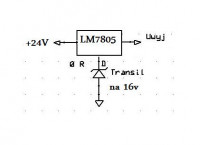"transil is something similar to a zener diode, but if you run the zener diode for even a millisecond
current 40A, it will probably burn, and the transil will withstand it. I don't know how exactly transiles behave
available relatively cheaply in the trade if overloaded - perhaps (that would be best) they give
for a moment, a complete short circuit (and therefore they do not heat up any more), and when they cool down, they become zeners again. Or
they can stay together forever... in any case, the characteristics of the transil are given in the data sheet until
current is small, it behaves like a zener for some voltage, e.g. 6.8V, and at very high currents, such as
tens of amperes, the voltage can reach up to 13V"
I mean the bold text - what is it like?
current 40A, it will probably burn, and the transil will withstand it. I don't know how exactly transiles behave
available relatively cheaply in the trade if overloaded - perhaps (that would be best) they give
for a moment, a complete short circuit (and therefore they do not heat up any more), and when they cool down, they become zeners again. Or
they can stay together forever... in any case, the characteristics of the transil are given in the data sheet until
current is small, it behaves like a zener for some voltage, e.g. 6.8V, and at very high currents, such as
tens of amperes, the voltage can reach up to 13V"
I mean the bold text - what is it like?




